[ad_1]
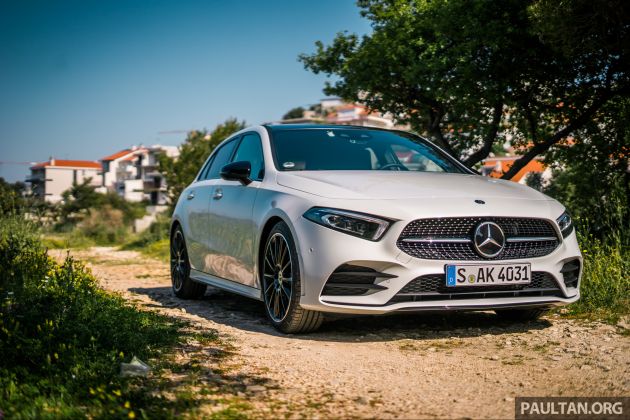
Necessity is the mother of invention, they say. Except with the Mercedes-Benz A-Class it was the exact opposite. Unveiled to great fanfare in 1997, Stuttgart’s entry-level model was initially a revolutionary MPV-style hatchback that promised big space in a small footprint, predating the Honda Jazz by a whole four years.
But as customers became more upwardly mobile and image conscious, they became less interested in space or practicality; those considerations fell into the background as style took precedence. It was all about looking good, silly, and the original A-Class was about as fashionable as a pair of beige corduroys.
Clearly, Mercedes took inspiration from Audi – which had for years been building the safe, conventional, handsome A3 – because after sticking with the tallboy bodystyle for one more generation, it then introduced a safe, conventional, handsome A-Class in 2012. Never mind that it was smaller on the inside despite being so much larger on the outside, or that it rode like a skateboard – it was a hit.
Now, then, to the new W177 A-Class. Mercedes has stuck to its tried and tested formula but has given the car a polarising new look, stuffed it will a slew of new technologies and has tried turning the ride into something approaching comfortable. Has it all worked? We’ve travelled all the way to Croatia to find out.
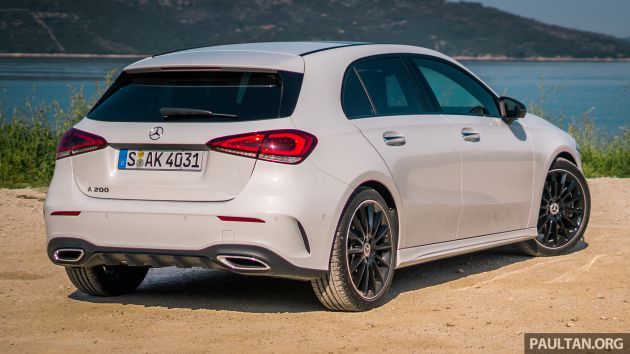
The outgoing W176 model wasn’t exactly small, but that hasn’t stopped Mercedes from stretching the A-Class considerably. Measuring 4,419 mm long, 1,796 mm wide and 1,440 mm tall, the new car is a whopping 127 mm longer, 16 mm wider and 7 mm taller than before, and its 2,729 mm wheelbase is 30 mm longer.
All this results in lankier, more relaxed proportions that make the A-Class look more mature and sophisticated on the outside. That doesn’t mean that Mercedes has given up chasing the younger crowd, as the design has been given a whole new twist in line with the latest iteration of the company’s Sensual Purity styling language.
The low front end has been lifted almost wholesale from the new CLS, with a trapezoidal grille flanked by tapered headlights, while the bonnet shutline is now inset into the body and separated from the grille and headlights – a treatment usually reserved for Mercedes’ higher-end coupés like the S-Class Coupé.
The body side surfacing has been simplified, dispensing with the W176’s upswept lower character line; the new horizontal lines emphasise the car’s length. Moving to the rear, the car appears wider thanks to the glasshouse that tapers more towards the top, along with the broader two-piece tail lights. As usual, there’s a more aggressive AMG Line styling package, along with wheel options now measuring up to 19 inches.
Also optional are LED High Performance headlights, along with Multibeam LED headlights that feature 18 individual high-beam diodes – these can be switched off individually to avoid blinding other motorists, allowing for permanent use of the high beams. Opting for either one of these headlights will also give you uprated tail lights with light guides that go all around the perimeter, reminiscent of those you’ll find on the back of a Kia Cerato – as pointed by more than one journalist during the media test drive.
Inside, the A-Class follows the template first set by the W222 S-Class, with round air vents (featuring the now familiar turbine-inspired vanes) and a large widescreen display panel – now completely freestanding. As standard, the two instrument and infotainment displays measure seven inches across, but they can both be bumped up to 10.25-inch units; the centre screen is now a touch-sensitive unit as well.
The new Mercedes-Benz User Experience (MBUX) makes its debut on the new A-Class. In keeping with the general industry trend of smartphone-inspired user interfaces, the system finally gets a home screen, with large icons and snippets of live information, similar to version 6.0 of BMW’s iDrive (BMW has since switched to a different design with even bigger customisable widgets). There’s also an impressive new augmented reality navigation function that overlays blue arrows and street names onto a feed from a front-facing camera.
On models with the range-topping Widescreen Cockpit flatscreens, the instrument display has been redesigned, with a twin-dial layout that can be customised with different bits of information. The interface also allows certain functions of the car, such as the driver assistance systems and the map from the navigation system, to be shown in fullscreen mode.
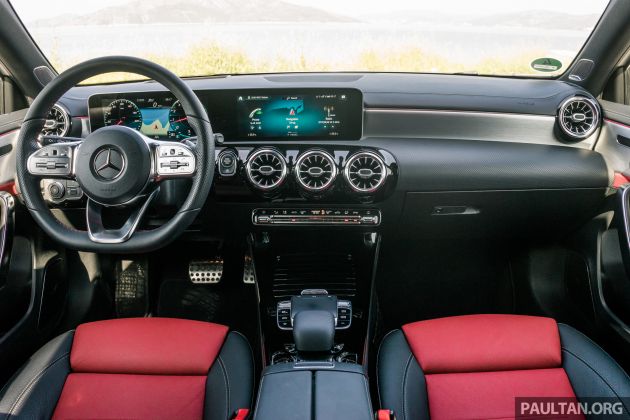
As you’d expect, the systems work intuitively enough, especially with the new touchscreen. The new touchpad, which replaces the Comand knob, is a little less successful – although it’s not nearly as wayward as Lexus’ haphazard Remote Touch interface, it’s still not quite precise enough when you’re on the move.
During my time with the car, I much preferred using the pads on the steering wheel, because at least I could keep both hands on the tiller. Also, the USB ports throughout the car are now all USB-C, which for most people means a trip to Digital Mall for a new cable or at least an adapter.
Mercedes is also pushing the system’s artificial intelligence functionality, which uses machine learning to adapt to the user’s habits and preferences. For example, the car will populate the Suggestions menu with playlists you often listen to, navigation directions to places you usually go to and the people you call the most, depending on the time of day.
Then there’s the much-vaunted Linguatronic voice control, acting as a personal assistant in a similar vein to Apple’s Siri and Amazon’s Alexa. Using the activation term, “Hey Mercedes,” you can operate various aspects of the vehicle, such as music playback, climate control and navigation.
The standout feature is the ability to understand not only natural language but also indirect speech – saying “I am cold,” for example, will instruct the climate control to raise the temperature. The system is also able to learn your speech and can understand non-native English speakers better, and new buzzwords and changes in the language will be uploaded to the cloud over time.
Voice control is an easy way to impress your mates, but I’m not convinced that the system as it stands today will be of much use. That novel climate control function is pretty cool (excuse the pun), but it only adjusts the temperature in one-degree increments each time, so it’s not exactly practical. And hardly anyone in Malaysia uses the built-in navigation system, so the features built into the voice control – such as the What3Words function that lets you go anywhere in the world using a three-word address – will all be for nought over here.
You get the sense that all this technology, the shiny bits of metal trim and the glitzy ambient lighting system – which, by the way, can now perform a flashy colour-changing light show – are there to distract you from some of the areas in which Mercedes has cut some corners, or simply hasn’t move the game on as significantly from the outgoing model as we would’ve liked.
Material quality on a whole is decent, with plenty of soft-touch materials dotted around the cabin. But just like in its predecessor, you only have to go below chest height in this new car to find hard, scratchy plastic, and the swathes of gloss black trim are magnets for fingerprints and scratches. The column-mounted gearshift and indicator stalks are a particular disappointment – the thin, flimsy sticks are a world away from the usual hefty Mercedes pieces, and impart nothing like the feeling of solidity serial Merc owners are used to.
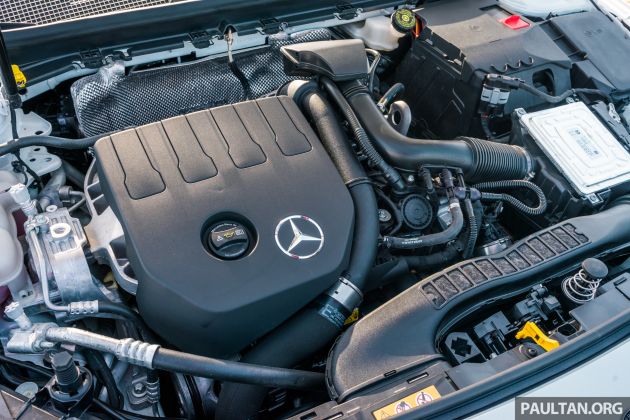
Practicality, meanwhile, has been much improved thanks to the sizeably larger body, with rear passengers in particular gaining a considerable amount of legroom in the process. It’s still not what you’d call roomy – the Jazz will run rings around it – but it’s much improved over the old model, which was really rather cramped at the back. Boot space has also increased by 29 litres to 370 litres.
Safety-wise, the car is available with a whole array of semi-autonomous driving technologies from its larger siblings. Aside from the standard Active Brake Assist autonomous emergency braking, buyers can also specify the Driving Assistance Package that adds Distronic adaptive cruise control, Active Steering Assistant and Active Lane Change Assistant that takes care of steering, acceleration, braking and will even change lanes for you at speeds of up to 210 km/h. None of which, of course, are offered in Malaysia, AEB aside.
The new A-Class is offered worldwide at launch with a choice of three four-cylinder engines – two petrol and one diesel. Other engine options will be made available later on, including a new entry-level AMG model, the A 35 with 306 hp and 400 Nm from a 2.0 litre mill. The A 45 will continue to sit at the top of the range, with outputs reportedly pushing upwards of 400 hp.
In the meantime, there’s the A 180 d with an upgraded OM608 version of the previous 1.5 litre turbodiesel. It now has an electronically-controlled variable geometry turbocharger integrated into the exhaust manifold, an intake manifold integrated into the cylinder head cover and a selective catalytic reduction (SCR) system with AdBlue injection. All in all, it makes 116 hp at 4,000 rpm and 260 Nm of torque from 1,750 to 2,500 rpm.
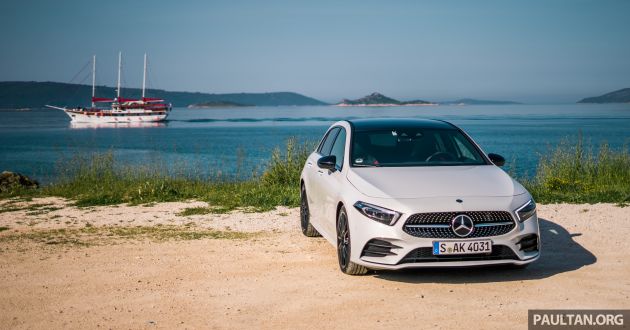
Of more relevance are the two petrol models, both of which have just been launched in Malaysia. The big news is that the A 200 dispenses with its 1.6 litre turbo mill in favour of an even smaller 1.33 litre M282 unit, developed in partnership with Renault – as is the diesel. It features active cylinder shutoff, an electronic wastegate, Nanoslide-coated cylinder walls to minimise friction and a delta-shaped cylinder head.
Despite the reduction in swept volume, power has actually increased by seven horsepower to 163 hp at 5,500 rpm; peak torque holds station at 250 Nm between 1,620 and 4,000 rpm. Meanwhile, the A 250 uses a development of Mercedes’ own 2.0 litre unit – the new M260 makes 224 hp at 5,500 rpm and 350 Nm between 1,800 to 4,000 rpm, an increase of six horsepower.
Modifications over the old engine include Conicshape cylinder bores that are slightly wider at the bottom – again to reduce friction – along with piston cooling ducts, Camtronic variable valve lift, an improved BlueDirect lean-burn combustion system and a centrifugal damper for better refinement. Both petrol engines get a particulate filter, and all models meet Euro 6d-TEMP emissions regulations.
Fuel consumption is rated at 4.1 litres per 100 km for the A 180 d, 5.2 litres per 100 km (5.8 litres per 100 km with a six-speed manual gearbox) for the A 200 and 6.2 litres per 100 km for the A 250. As before, a seven-speed wet dual-clutch transmission is offered on all models, but the one in the A 200 and A 180 d now comes from Getrag; the former is also available with the aforementioned manual ‘box.
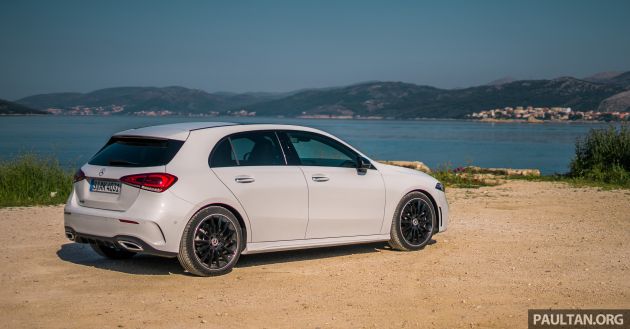
The A 250 gets a refined version of the existing Mercedes unit, with improved shift performance and response thanks to an optional friction system and pistons with lower hysteresis; it also has improved communication with the engine for faster shifts in manual mode. Both petrol models get an optional 4Matic all-wheel drive system that can now send up to 100% of torque to the rear wheels.
We’ve driven the petrol models on the roads surrounding the seaside city of Split, and the A 200 is definitely the lesser of the two, and not just because of the lower numbers. It’s certainly not slow – Mercedes claims a zero-to-100 km/h time of just eight seconds flat, and once the car gets going it feels every bit as quick as that.
What the figures don’t tell you is that in practice, the engine just doesn’t feel like it has the broad, flat torque curve that you come to expect from a modern turbo engine. There’s a bit of turbo lag before the thrust kicks in, and while the mill does have strong mid-range punch, it starts to run out of puff by the time you reach the upper third of the rev counter.
The relative lack of low-down pull is likely the reason why the transmission is so eager to downshift whenever you prod the throttle. Too eager, in fact, to the point that progress becomes rather jerky in the cut and thrust of urban traffic. It also betrays the engine’s vocal, gruff grumble when worked hard, a noise that is at odds with the car’s otherwise refined nature.
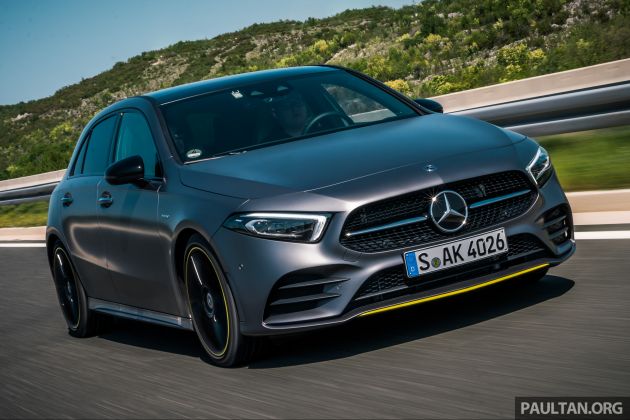
If the A 200, for all its foibles, delivers a decent turn of speed, then the A 250 is outright fast, hitting 100 km/h in a blistering 6.2 seconds. This is the engine with which the A-Class is at its most comfortable – it’s more eager to rev, and when it does it makes a smoother, more pleasant sound. The DCT is also less prone to hunting for the right gear here, making for a more easygoing drive.
And what about the handling? That will likely depend on what chassis setup you opt for – and this time there’s a bigger difference between the various suspension options. More powerful models like the A 250 retain the independent four-link rear suspension, as do vehicles with optional adaptive damping, all-wheel drive and/or wheels larger than 19 inches in diameter.
More controversial is that the A 200 and A 180 d receive – shock, horror! – a simpler, more rudimentary torsion beam setup, which could vastly affect the car’s road manners. As before, the front suspension is made up of MacPherson struts, and electric power steering with speed-sensitive assistance is standard-fit.
It should be noted that all the cars we drove, while front-driven, were fitted with adaptive damping and thus had multilink rear suspension across the board – so we’ll have to reserve judgement on the A 200 until we have a go in a car in local specification, which has the torsion beam setup.
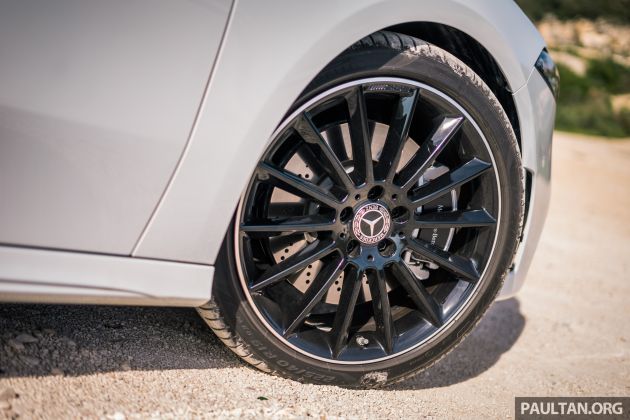
As it stands, with all the option boxes ticked, the A-Class is a much more resolved car than its predecessor. Whereas the old model would clatter over any surface imperfection, this new one has actual compliance and, with the dampers set to Comfort mode, handles minor bumps and undulations pretty well. But it’s not perfect, as it still crashes over larger potholes, especially on the test cars’ massive 19-inch alloys.
Thankfully, the added pliancy over rough roads hasn’t dulled the car’s verve in the corners. Turn in and body movements are resolutely well controlled, grip levels are fairly high and when the chassis does wash into understeer, it does so in a stable, predictable manner.
If only the steering was more direct. This likely has much to do with the steering assistance function, thrown in as part of the Driving Assistance package, that corrects any form of undesirable handling quirk. Mercedes has asked a lot from this system – it has to countersteer in the event of oversteer, balance out torque steer, make corrections when braking on split surfaces and compensate for crosswinds and road camber.
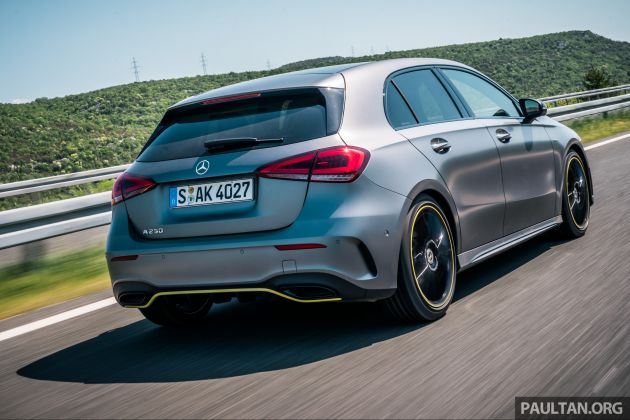
As a consequence of this, the steering instead feels inert and doesn’t communicate as much from the front wheels to your hands as you’d like. While the chassis is still eager to sniff out the apex of a corner, you always have to second guess where exactly the car is headed at any given moment. Again, our cars won’t come with the Driving Assistance package, so we’ll just have to wait and see if this holds true over here.
At the end of the day, the new A-Class is a decent step forward from the old model, in the two key areas the latter has always faltered. Not only is it a marginally roomier, more practical family car, but it is also more refined and delivers a far more cosseting ride on first blush – with the usual caveat of us needing to drive local units on local roads for a definitive assessment.
But is it a big enough step? I’m not so sure – for all these improvements, this remains a fairly average car to drive in a sea of increasingly more capable machines in the mainstream C-segment. And that’s before the arrival of the new Audi A3 and BMW 1 Series, the latter of which is also set to go front-wheel drive in the next generation, much to the fear and loathing of purists worldwide.
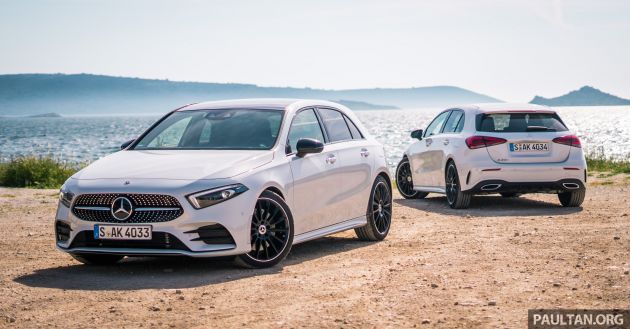
Perhaps this marks a shift in what it means to be a Mercedes-Benz. That it no longer stands for superiority in mechanical engineering or ride comfort – not that the car is by any means poor in those respects – but is more about delivering the style and panache that buyers ask for these days and packing the car with the sort of technologies that make a Silicon Valley engineer weak at the knees.
And in that respect the A-Class definitely succeeds. The old car, warts and all, has become such a desirable object for the younger generation that is flocking to the Three-Pointed Star these days, and the new one is well on its way to following in those footsteps. The fact that all these infotainment and artificial intelligence features are debuting here, and not in the S-Class – the crown jewel of the lineup – is telling.
There will be those who will bemoan this approach, but I don’t think it’s such a bad thing. There’s nothing better to end a bad day than to slide into a cabin that surprises and delights, one that dazzles you with big, beautiful screens and colourful lights glinting in the cold metal trim. Sometimes, not even a spirited blast down your favourite road can cure you quite so completely.
The new W177 Mercedes-Benz A-Class has been launched in Malaysia, priced at RM227,888 for the A 200 Progressive Line and RM263,888 for the A 250 AMG Line. Browse full specifications and equipment on CarBase.my.
GALLERY: Mercedes-Benz A 200 Progressive Line in Malaysia
GALLERY: Mercedes-Benz A 250 AMG Line in Malaysia
[ad_2]
Source link